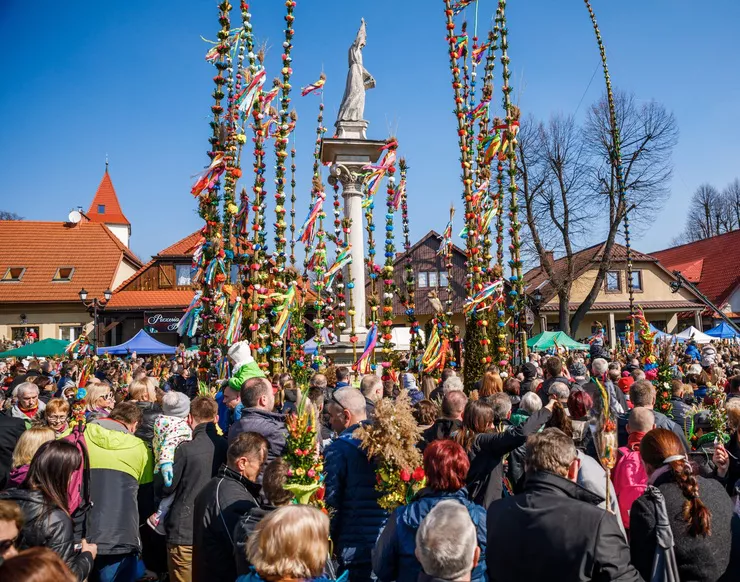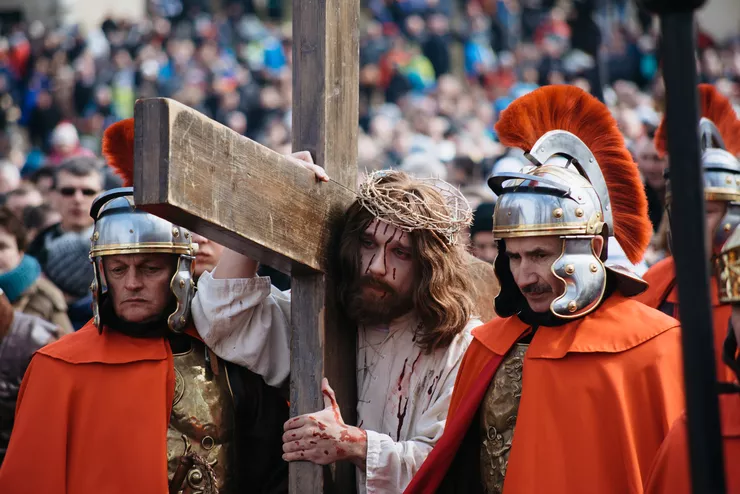





Małopolska Rites of Spring.
There is no other time for joyful celebration like the end of winter slumber, when all the nature is joyfully springing to life. Little wonder, all cultures and religions have developed particular celebrations for this time. Many of them are observed in local communities of Małopolska, a region that has retained many traditions, some of which date back to pagan times and have been transformed by not only the Western but also Orthodox and Greek churches.

A crucial element of religious observances of Easter Week are the Passion plays on Good Friday. The most famous Mystery of the Passion of Christ has long been held at “the Calvary” that is the Sanctuary of Christ’s Passion in Kalwaria Zebrzydowska modelled four centuries ago on Calvary (Golgotha) in Jerusalem. The hill above the Kalwaria Zebrzydowska Basilica is graced by the last of a long line of pilgrimage chapels running from the slope of another hill and crossing the stream in the valley below. The Passion Week prayerful reenactments start on Palm Sunday with Jesus entering Jerusalem on a donkey, welcomed by thousands.
In 1999, in recognition of the cultural and religious significance of the rites of the Easter Week, and notably the Mystery of the Passion, UNESCO named Kalwaria Zebrzydowska a World Heritage Site.
Lipnica Murowana cultivates an ancient custom of building many-metre-tall palms and displaying it around St Simon’s statue of in the town’s market square on Palm Sunday. As tradition bans any “unnatural” elements in the construction, they are mostly made of willow reeds and decorated with juniper, colourful dried and tissue-paper flowers, and ribbons. The builders of the tallest palm are revered throughout the following year, and the competition is part of a fair with performances by folk groups that attract large audiences every year.
Lent and Easter may be a good reason to visit Miechów, whose extraordinary Basilica houses a copy of the Holy Sepulchre inside. The Equestrian Order of the Holy Sepulchre of Jerusalem in Miechów dating back to the time of the first crusades makes sure that the Easter Week is observed with great reverence and solemnity.
One of the non-religious traditions is observed in a particular area north of Kraków. If you wake up on Palm Sunday e.g. in Babice, Zielonki, Trojanowice, or Tomaszowice, you will quite likely be visited by Pucheroki. They are boys in conical caps of colourful tissue paper, wearing their sheepskins inside out, with faces painted with black soot. Some believe the custom originated with the students of Kraków University before it was called Jagiellonian, who visited homes asking for small donations, and paying for them with witty couplets and best wishes for Easter.
In turn, on Easter Monday in Wieliczka and nearby Lednica Górna, you can meet Siuda Baba – a soot-stained, scruffy figure wearing a torn skirt. The legend speaks of priestesses spending a whole year in a temple of Leda, where a sacred fire burnt for the goddess. With her term being completed with the coming of spring, the priestess, greased from the fire fuelled with animal fat, visited the houses in search of a successor. Rather than dragging girls to altars, the 21st-century Siuda Baba lets them go free against a payment of some money or a kiss, which, however, ends with the girl’s face getting some of Baba’s soot.
Also on Easter Monday, the streets of Dobra are prowled by Dziady Śmiguśne: masked young men dressed in straw costumes. The custom is supposedly derived from a Tartar invasion of the monastery in Szczyrzyc in the 13th century.
By the way of Dziady Śmiguśne, have we mentioned that Easter Monday is known throughout Poland as Śmigus Dyngus – the day when you can be sprinkled with water? Today usually in moderate amounts, yet in the villages of the past these could have been whole bucketfuls of cold water thrown over you, with some even practicing the custom of throwing maidens into duck ponds.
For more locations in Małopolska offering unique customs click here, and for the beautiful and ancient tradition of blessing food on Easter Saturday, here.
If you’re curious to know what Easter palms look like also outside Małopolska, the Ethnographic Museum in Kraków boasts a collection of approximately 250 such palms, some of them a hundred years old.
Each year, the number of pilgrims from Poland and abroad visiting Kalwaria Zebrzydowska throughout the Easter Week reaches 150,000.








